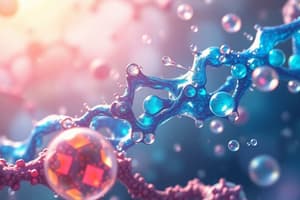Podcast
Questions and Answers
What process do fatty acids undergo to be transformed into acetyl CoA for entry into the Kreb's cycle?
What process do fatty acids undergo to be transformed into acetyl CoA for entry into the Kreb's cycle?
- Beta oxidation (correct)
- Lipogenesis
- Glycolysis
- Fermentation
What is the primary role of catabolic processes within a cell?
What is the primary role of catabolic processes within a cell?
- To synthesize lipids
- To provide energy for building reactions (correct)
- To transport nutrients
- To build complex molecules
Which type of microorganism must obtain its carbon in an organic form?
Which type of microorganism must obtain its carbon in an organic form?
- Heterotroph (correct)
- Phototroph
- Autotroph
- Chemotroph
Which of the following nutrients is essential for stabilizing cell walls and endospores in bacteria?
Which of the following nutrients is essential for stabilizing cell walls and endospores in bacteria?
Which nutrient serves as a crucial component of chlorophyll in organisms?
Which nutrient serves as a crucial component of chlorophyll in organisms?
What is the outcome for a cell placed in a hypotonic solution?
What is the outcome for a cell placed in a hypotonic solution?
Which type of microbe gets its energy from chemical reactions?
Which type of microbe gets its energy from chemical reactions?
What type of nutrients do macronutrients represent?
What type of nutrients do macronutrients represent?
What is the primary goal of sterilization in microbial control?
What is the primary goal of sterilization in microbial control?
Which method can distinguish between live and dead cells?
Which method can distinguish between live and dead cells?
What does microbial stasis refer to?
What does microbial stasis refer to?
Which antimicrobial agent is commonly used to destroy vegetative pathogens?
Which antimicrobial agent is commonly used to destroy vegetative pathogens?
What is the effect of surfactants in microbial control?
What is the effect of surfactants in microbial control?
What is the primary function of enzymes in metabolism?
What is the primary function of enzymes in metabolism?
How does heat function as an antimicrobial agent?
How does heat function as an antimicrobial agent?
Which statement about microbial death is accurate?
Which statement about microbial death is accurate?
Which of the following best describes catabolism?
Which of the following best describes catabolism?
What happens during enzyme denaturation?
What happens during enzyme denaturation?
Microbes can be categorized based on resistance. Which group has the highest resistance?
Microbes can be categorized based on resistance. Which group has the highest resistance?
Which group of microbes is characterized by an optimum temperature below 15°C?
Which group of microbes is characterized by an optimum temperature below 15°C?
Which of the following is true about constitutive enzymes?
Which of the following is true about constitutive enzymes?
What type of respiration utilizes $CO3^{2-}$ as a final electron acceptor?
What type of respiration utilizes $CO3^{2-}$ as a final electron acceptor?
What is the primary characteristic of facultative anaerobes?
What is the primary characteristic of facultative anaerobes?
What is the initial process all three metabolic strategies begin with?
What is the initial process all three metabolic strategies begin with?
What defines the optimum temperature for a microorganism?
What defines the optimum temperature for a microorganism?
During which phase of the growth curve do newly inoculated cells require adjustment before division?
During which phase of the growth curve do newly inoculated cells require adjustment before division?
How does the regulation of enzyme synthesis occur?
How does the regulation of enzyme synthesis occur?
What is primarily stored as energy in cells?
What is primarily stored as energy in cells?
What is a common characteristic of halophiles?
What is a common characteristic of halophiles?
What is the purpose of binary fission in microbial growth?
What is the purpose of binary fission in microbial growth?
Which type of microbe is harmed by normal atmospheric concentrations of oxygen but requires a small amount for growth?
Which type of microbe is harmed by normal atmospheric concentrations of oxygen but requires a small amount for growth?
What does the term generation time refer to in microbiology?
What does the term generation time refer to in microbiology?
What is the function of the reverse transcriptase enzyme in HIV?
What is the function of the reverse transcriptase enzyme in HIV?
What is superinfection?
What is superinfection?
Which test provides data on antimicrobial susceptibility?
Which test provides data on antimicrobial susceptibility?
Which of the following best describes multi-drug resistant (MDR) pumps?
Which of the following best describes multi-drug resistant (MDR) pumps?
What does the minimum inhibitory concentration (MIC) represent?
What does the minimum inhibitory concentration (MIC) represent?
What can cause antimicrobial treatment to fail?
What can cause antimicrobial treatment to fail?
What is a significant side effect of drug therapy?
What is a significant side effect of drug therapy?
What role does interferon play in the immune response?
What role does interferon play in the immune response?
What is the thermal death point defined as?
What is the thermal death point defined as?
What is the main goal of pasteurization?
What is the main goal of pasteurization?
Which type of radiation is specifically termed ionizing radiation?
Which type of radiation is specifically termed ionizing radiation?
What is a characteristic of quaternary ammonium compounds?
What is a characteristic of quaternary ammonium compounds?
What action do intermediate-level germicides primarily target?
What action do intermediate-level germicides primarily target?
What is the mechanism by which alcohol inactivates enveloped viruses?
What is the mechanism by which alcohol inactivates enveloped viruses?
What is the primary active component in hydrogen peroxide that contributes to its germicidal effects?
What is the primary active component in hydrogen peroxide that contributes to its germicidal effects?
What characteristic is associated with ethylene oxide (ETO)?
What characteristic is associated with ethylene oxide (ETO)?
Flashcards
Metabolism
Metabolism
The sum of all chemical reactions in a living organism that are necessary to maintain life.
Anabolism
Anabolism
The process of building up complex molecules from simpler ones, requiring energy.
Catabolism
Catabolism
The process of breaking down complex molecules into simpler ones, releasing energy.
Enzymes
Enzymes
Signup and view all the flashcards
Cofactors
Cofactors
Signup and view all the flashcards
Coenzymes
Coenzymes
Signup and view all the flashcards
Denaturation
Denaturation
Signup and view all the flashcards
Constitutive Enzymes
Constitutive Enzymes
Signup and view all the flashcards
Beta Oxidation
Beta Oxidation
Signup and view all the flashcards
Deamination
Deamination
Signup and view all the flashcards
Bioelements
Bioelements
Signup and view all the flashcards
Essential Nutrient
Essential Nutrient
Signup and view all the flashcards
Macronutrients
Macronutrients
Signup and view all the flashcards
Micronutrients
Micronutrients
Signup and view all the flashcards
Heterotroph
Heterotroph
Signup and view all the flashcards
Optimum Temperature
Optimum Temperature
Signup and view all the flashcards
Psychrophiles
Psychrophiles
Signup and view all the flashcards
Mesophiles
Mesophiles
Signup and view all the flashcards
Obligate Aerobe
Obligate Aerobe
Signup and view all the flashcards
Facultative Anaerobe
Facultative Anaerobe
Signup and view all the flashcards
Binary Fission
Binary Fission
Signup and view all the flashcards
Generation Time
Generation Time
Signup and view all the flashcards
Lag Phase
Lag Phase
Signup and view all the flashcards
Stationary Phase
Stationary Phase
Signup and view all the flashcards
Death Phase
Death Phase
Signup and view all the flashcards
Direct Cell Count
Direct Cell Count
Signup and view all the flashcards
Coulter Counter
Coulter Counter
Signup and view all the flashcards
Flow Cytometer
Flow Cytometer
Signup and view all the flashcards
Sterilization
Sterilization
Signup and view all the flashcards
Microbistasis
Microbistasis
Signup and view all the flashcards
Disinfection
Disinfection
Signup and view all the flashcards
Thermal Death Time
Thermal Death Time
Signup and view all the flashcards
Thermal Death Point
Thermal Death Point
Signup and view all the flashcards
Pasteurization
Pasteurization
Signup and view all the flashcards
Irradiation
Irradiation
Signup and view all the flashcards
Ionizing Radiation
Ionizing Radiation
Signup and view all the flashcards
Nonionizing Radiation
Nonionizing Radiation
Signup and view all the flashcards
Filtration
Filtration
Signup and view all the flashcards
Alcohol's Action on Viruses
Alcohol's Action on Viruses
Signup and view all the flashcards
Reverse Transcriptase
Reverse Transcriptase
Signup and view all the flashcards
Interferon
Interferon
Signup and view all the flashcards
Drug Resistance
Drug Resistance
Signup and view all the flashcards
MDR Pumps
MDR Pumps
Signup and view all the flashcards
Biofilms
Biofilms
Signup and view all the flashcards
Superinfection
Superinfection
Signup and view all the flashcards
Kirby-Bauer Technique
Kirby-Bauer Technique
Signup and view all the flashcards
Minimum Inhibitory Concentration (MIC)
Minimum Inhibitory Concentration (MIC)
Signup and view all the flashcards
Study Notes
Chapter 8 Notes
- Metabolism is the sum of all chemical reactions in the body needed to maintain homeostasis. It includes two types:
- Anabolism: building up macromolecules for structure and function
- Catabolism: breaking down macromolecules to produce energy
- Enzymes are biological catalysts that speed up chemical reactions by lowering activation energy. They are not part of the products and remain unchanged during the process. Cofactors, like coenzymes, support enzyme function.
- Denaturation occurs when weak bonds maintaining an enzyme's shape are broken. This alters the enzyme's shape, preventing substrate attachment to the active site.
- Constitutive enzymes are present in consistent amounts, regardless of substrate levels. Regulated enzymes adjust in concentration based on substrate levels.
- Enzyme activity can be controlled through induction or repression of synthesis.
- Energy is primarily stored as ATP. Oxidation-reduction (redox) reactions transfer energy.
Chapter 7 Notes
- Bioelements are essential elements for all living organisms. Macronutrients are needed in large quantities for structural roles. Micronutrients (trace elements) are involved in maintaining enzyme function.
- Inorganic nutrients include atoms/molecules other than carbon and hydrogen. Organic nutrients contain both carbon and hydrogen. Examples of essential elements include potassium (K), sodium (Na), calcium (Ca), magnesium (Mg), iron (Fe), and zinc (Zn).
- Temperature affects microbial growth. Minimum temperature is the lowest for growth, maximum for highest growth, and optimum for fastest rates. Psychrophiles thrive in cold temperatures, psychotrophs can grow in refrigeration, and thermophiles thrive in high temperatures.
- Carbon and energy sources classify microbes. Heterotrophs use organic carbon, and autotrophs use inorganic carbon. Phototrophs obtain energy from light, and chemotrophs from chemical reactions.
- Microbial growth patterns include lag phase (initial adjustment), exponential growth (log phase/rapid growth), stationary phase (growth rate = death rate), and death phase (significant cell death).
- Different microbes thrive in various environments, with some needing oxygen (aerobes) and others not (anaerobes) and even requiring specific oxygen levels (microaerophiles).
- Microbes can grow in acidic (acidophiles) or basic (alkaliphiles) environments. Different organisms have optimal temperature ranges.
Chapter 11 Notes
- Contaminants are unwanted microbes.
- Decontamination employs physical and chemical agents targeting various groups of microorganisms, with varying degrees of resistance to these agents (highest, moderate, and least).
- Sterilization eliminates all types of microbes, including spores. Disinfection reduces the number of undesirable microbes on non-living surfaces.
- Methods include heat (moist and dry), radiation (ionizing and non-ionizing), and filtration. Chemical agents like alcohols (disinfectant/antiseptic), halogens (chlorine and iodine), hydrogen peroxide, and quaternary ammonium compounds are also used.
Chapter 12 Notes
- Antimicrobial treatment aims to eliminate pathogens without harming the host.
- Antibiotics are produced by microbes that kill or inhibit other microbes.
- Many mechanisms of action exist, targeting cell walls (e.g., penicillin), nucleic acids (e.g., rifampin, sulfonamides), , protein synthesis (e.g., tetracyclines), and diverse metabolic pathways.
- Drug resistance poses challenges. Resistance can occur through various mechanisms in many species of microbes.
- Other outcomes of antimicrobial therapy include treatment failure due to drug inability to penetrate a body compartment or the presence of drug-resistant strains.
Studying That Suits You
Use AI to generate personalized quizzes and flashcards to suit your learning preferences.



